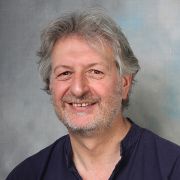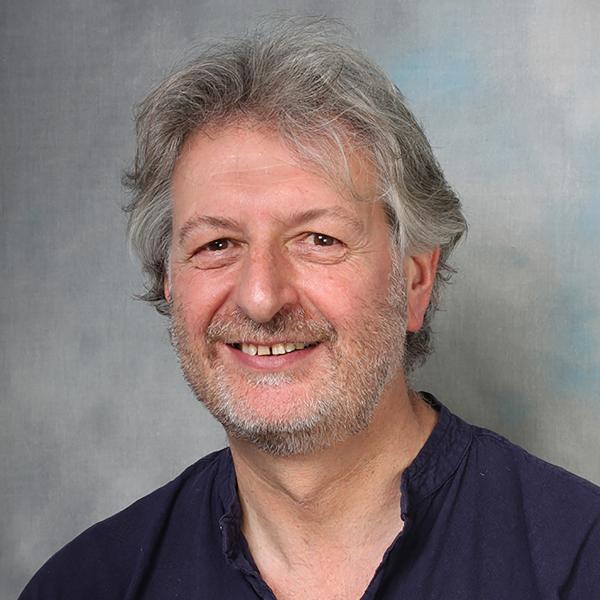Professor Jim A. Thomas
School of Mathematical and Physical Sciences
Professor of Bio-inorganic Chemistry


Full contact details
School of Mathematical and Physical Sciences
Dainton Building
13 Brook Hill
∫˘¬´”∞“µ
S3 7HF
- Profile
-
Prof. Thomas obtained a BSc in Chemistry from the University of Reading in 1982 and a PhD from the University of Birmingham in 1993. After his PhD he became a Royal Society European Exchange Fellow at the Universite Louis Pasteur in Strasbourg in 1993, followed by a postdoctoral fellowship at the University of ∫˘¬´”∞“µ in 1994. In 1995 he was appointed as a Royal Society University Research Fellow.
In 2004 he was appointed lecturer and promoted to senior lecturer (2007), reader (2010), and professor (2015).
- Qualifications
-
- PGCE (1983)
- Research interests
-
My group is particularly interested in using photochemically and/or electrochemically active metal centres to produce functional molecular architectures. Most of our work is inspired in some way by biological systems. For example, by using a combination of hydrogen and coordination bonding we are investigating the metal-ion directed self-assembly of hosts and sensors for anions, bioanions and biomolecules.
Using a similar approach we are creating hosts that function as molecular devices such as ion-gated switches. Finally, we are very interested at the way oligonuclear luminescent coordination complexes interact with biomolecules such as DNA. This work includes in cellulo studies aimed at identifying new optical imaging probes with multiple output modalities and also potential novel therapeutic leads.
- Publications
-
Journal articles
- . Acta Crystallographica Section E Crystallographic Communications, 79(4).


- . Angew Chem Weinheim Bergstr Ger, 134(27), e202117449.


- . Angewandte Chemie International Edition.


- . Angewandte Chemie.


- . ACS Pharmacology & Translational Science, 4(1), 168-178.


- . Chemical Science, 11(33), 8936-8944.


- . Chemical Science, 11(33), 8828-8838.


- . Chemical Science, 11(33), 8928-8935.


- . Chemical Communications, 56(57), 7945-7948.


- . Journal of the American Chemical Society.


- . Chemical Communications, 56(10), 1464-1480.


- . Journal of the American Chemical Society.


- . Chemical Science.


- . ACS Nano, 13(5), 5133-5146.


- . Journal of the American Chemical Society, 141(11), 4644-4652.


- . Journal of the American Chemical Society, 141(7), 2925-2937.


- . Chemical Science, 10(12), 3502-3513.


- . Chemical Communications.


- . Crystal Growth and Design, 18(11), 7199-7206.


- . Dalton Transactions, 47(35), 12300-12307.


- . Bioconjugate Chemistry.


- . Nanoscale, 10(22), 10596-10608.


- . Chemical Communications, 54(30), 3735-3738.


- . Dalton Transactions, 47(14), 4931-4940.


- . Chemical Communications, 54(15), 1849-1852.


- . Analytical Chemistry, 89(22), 12087-12093.


- . Chemical Science, 9, 841-849.


- . Journal of the American Chemical Society, 139(44), 15907-15913.


- . Chemical Communications, 53, 12672-12675.


- . Angewandte Chemie International Edition, 129(41), 12802-128007.


- . New Journal of Chemistry, 41(14), 6911-6921.


- . Chemistry - A European Journal, 23(23), 5389-5389.


- . Dalton Transactions, 46, 6634-6644.


- . Dalton Transactions.


- . Chemistry A European Journal.


- . Chemistry - A European Journal, 22(17), 5996-6000.


- . Chemistry - A European Journal, 22(9), 3139-3147.


- . Chemistry - A European Journal, 21(39), 13723-13731.


- . ACS Applied Materials & Interfaces, 7(33), 18707-18716.


- . Chemical Society Reviews, 44(14), 4494-4500.


- . Chemistry - A European Journal, 21(33), 11865-11871.


- . Chemistry - A European Journal, 21(25), 9185-9197.


- . Angewandte Chemie, 127(10), 3043-3046.


- . Angewandte Chemie International Edition, 54(10), 3000-3003.


- . Chemistry - A European Journal, 20(43), 14004-14011.


- . Angew Chem Int Ed Engl, 53(13), 3367-3371.


- . Chem Commun (Camb), 50(29), 3859-3861.


- . Chemistry - A European Journal.


- . J Med Chem, 56(21), 8674-8683.


- . Chemical Science.


- . Chemistry, 19(16), 5081-5087.


- . Coordination Chemistry Reviews.


- . Angewandte Chemie, 124(48), 12273-12276.


- . Angew Chem Int Ed Engl, 51(48), 12107-12110.


- . Inorg Chem, 51(20), 10483-10494.


- . ChemInform, 43(30), no-no.


- . Chem Soc Rev, 41(8), 3179-3192.


- . Inorg Chem, 51(1), 463-471.


- . Dalton Trans, 40(45), 12005-12016.


- . Chem Asian J, 6(9), 2339-2351.


- . Org Biomol Chem, 9(9), 3462-3470.


- . Chembiochem, 12(6), 877-880.


- . CHEMBIOCHEM, 12(4), 548-551.


- . Chemistry - A European Journal, 17(7), 2002-2002.


- . Chemistry - A European Journal, 17(7), 2089-2098.


- . Org Biomol Chem, 8(11), 2617-2621.


- . European Journal of Inorganic Chemistry, 2010(7), 995-995.


- . EUR J INORG CHEM(7), 1007-1012.


- . Chemistry, 16(8), 2407-2417.


- . Chemistry - A European Journal, 16(8), 2324-2324.


- . Org Biomol Chem, 8(3), 648-654.


- . J Phys Chem A, 113(46), 12754-12762.


- . NAT CHEM, 1(8), 662-667.


- . Inorganic Chemistry, 48(12), 5584-5584.


- . NAT CHEM, 1(1), 25-26.


- Ru(II) complexes as DNA probes in cell imaging applications. ABSTR PAP AM CHEM S, 237, 511-511.


- . CRYSTENGCOMM, 11(10), 2069-2077.


- . DALTON T(42), 9312-9321.


- . CHEM COMMUN(20), 2947-2949.


- . Inorg Chem, 47(24), 11551-11560.


- . Inorg Chem, 47(24), 11633-11643.


- . POLYHEDRON, 27(12), 2577-2584.


- . Chem Commun (Camb)(16), 1868-1870.


- . POLYHEDRON, 27(2), 559-573.


- . ChemInform, 38(35).


- . Chemical Society Reviews, 36(6), 1018-1018.


- . Chem Soc Rev, 36(6), 856-868.


- . Angewandte Chemie, 119(20), 3760-3762.


- . CrystEngComm, 9(5), 361-361.


- . Inorg Chem, 46(2), 409-416.


- Zwitterionic 2-(4-pyridyl)malondialdehyde sesquihydrate forms a helical, 3-D hydrogen-bonded lattice. CRYSTENGCOMM, 9(5), 360-363.


- . Angew Chem Int Ed Engl, 46(20), 3686-3688.


- . J Inorg Biochem, 100(8), 1314-1319.


- . Angewandte Chemie, 118(27), 4504-4506.


- . Angew Chem Int Ed Engl, 45(27), 4396-4398.


- . Dalton Trans(23), 2900-2906.


- . Chemistry, 12(17), 4611-4619.


- . Int J Oncol, 28(6), 1571-1575.


- . Chemistry, 12(8), 2188-2195.


- . Chemistry - A European Journal, 12(8), 2111-2111.


- . Dalton Trans(5), 705-709.


- . INORG CHIM ACTA, 359(3), 759-765.


- . Inorg Chem, 45(2), 821-827.


- . Chem Commun (Camb)(34), 4327-4329.


- . INORG CHIM ACTA, 358(7), 2292-2302.


- . INORG CHEM COMMUN, 8(4), 382-385.


- . Chemistry, 11(7), 2031-2046.


- . INORG CHIM ACTA, 358(4), 1113-1124.


- . Dalton Trans(1), 110-115.


- . Inorganica Chimica Acta, 358(12), 3377-3383.


- . Biochemistry, 43(43), 13657-13665.


- . Angewandte Chemie, 116(30), 4028-4031.


- . Angew Chem Int Ed Engl, 43(30), 3938-3941.


- . INORG CHIM ACTA, 357(10), 2827-2832.


- . ACTA CRYSTALLOGRAPHICA SECTION E-STRUCTURE REPORTS ONLINE, 60, M662-M663.


- . Inorg Chem, 43(1), 317-323.


- . INORG CHIM ACTA, 355, 280-285.


- . ChemInform, 34(38).


- . CHEM SOC REV, 32(4), 215-224.


- . Chem Commun (Camb)(10), 1152-1153.


- . Chem Commun (Camb)(18), 2026-2027.


- . INORG CHEM, 41(8), 2250-2259.


- . CHEM COMMUN(21), 2540-2541.


- . J CHEM SOC DALTON(24), 4732-4739.


- Building blocks for self-assembly: half-sandwich complexes of the [Ru([9]aneS(3))(2+) metal center. INORG CHIM ACTA, 323(1-2), 157-162.


- Deprotonation of a ruthenium (II) complex incorporating a bipyrazole ligand leading to optical and electrochemical switching. INORG CHEM COMMUN, 4(9), 475-477.


- . Inorg Chem, 39(11), 2385-2390.


- Atomic abacus. New Scientist, 165(2225), 40-43.


- Blast it. New Scientist(2250), 40-42.


- Gripping chemistry. NEW SCIENTIST, 160(2163), 36-39.


- Hydrogen-bond recognition of cyclic dipeptides in water. CHEM COMMUN(22), 2449-2450.


- Self-assembly of a supramolecular cube. CHEM COMMUN(16), 1681-1682.


- A highly coupled Ru-III-Ru-II system incorporating sulfur donor ligands. CHEM COMMUN(14), 1429-1430.


- Damage control. New Scientist(2120), 36-39.


- Characterisation of two different mixed-valence states in a strongly interacting dimolybdenum complex (Apr, pg 769, 1997). CHEMICAL COMMUNICATIONS(15), 1473-1473.


- . Chemical Communications(8), 769-770.


- Stereoisomerically controlled inorganic architectures: Synthesis of extended enantio- and diastereomerically pure ruthenium molecular wires and disks from enantiopure building blocks.. ABSTR PAP AM CHEM S, 213, 591-INOR.


- Stereoisomerically controlled inorganic architectures: Synthesis of extended enantio- and diastereo-merically pure tris-ruthenium disks from enantiopure building blocks. CHEM COMMUN(22), 2603-2604.


- Molecular wires: An electrochemical study of metal-metal interactions through chains of four carbon atoms (vol 15, pg 1409, 1996). POLYHEDRON, 15(12), 2103-2103.


- Molecular wires: An electrochemical study of metal-metal interactions through chains of four carbon atoms. POLYHEDRON, 15(9), 1409-1414.


- Stereoisomerically controlled inorganic architectures: Synthesis of enantio and diastereomerically pure ruthenium-palladium molecular rods from enantiopure building blocks. CHEM COMMUN(6), 701-702.


- Mono- and bimetallic bipyridyl polyene complexes containing 17-electron molybdenum mononitrosyl centers: Electrochemical, spectroscopic, and magnetic studies. INORG CHEM, 35(3), 760-774.


- . Inorg Chem, 35(2), 289-296.


- THE SYNTHESES OF SOME PARAMAGNETIC STILBAZOLE COMPLEXES AND AN EVALUATION OF THEIR REDOX AND MESOGENIC PROPERTIES. POLYHEDRON, 14(17-18), 2499-2504.


- STRUCTURE OF ORTHORHOMBIC TRIPHENYLPHOSPHINE OXIDE - A REDETERMINATION AT ROOM-TEMPERATURE. ACTA CRYSTALLOGR C, 49, 355-357.


- AN EPR, MAGNETIC AND ELECTROCHEMICAL STUDY OF ELECTRON EXCHANGE AND INTERMETALLIC INTERACTION THROUGH POLYENE BRIDGES. J CHEM SOC CHEM COMM(24), 1796-1798.


- . Dalton Transactions.


- . ACS Infectious Diseases.


- . Journal of the American Chemical Society.


- . Dalton Transactions.


- . Journal of Medicinal Chemistry.


- . Chemistry – A European Journal.


- . Chemical Society Reviews.


- . Chemistry – A European Journal.


- . Angewandte Chemie International Edition.


- . RSC Medicinal Chemistry.


- . Journal of the American Chemical Society.


- . Chemistry – A European Journal.


- . Chemical Science, 11(9), 2566-2566.


- . Materials Chemistry Frontiers.


- . Chemical Science, 6(7), 4373-4374.


- . Chemical Science, 6(2), 1334-1340.


- . Chem. Commun., 50(93), 14494-14497.


- . ChemInform, 24(24), no-no.


- . Chemical Science.


- The Management of Mercury from Dental Amalgam in Wastewater Effluent. Environmental Technology Reviews.


Chapters
- Self-Assembly: Definition and Kinetic and Thermodynamic Considerations In Atwood JL & Steed JW (Ed.), Encyclopedia of Supramolecular Chemistry Marcel Dekker Inc


- , Ruthenium Complexes (pp. 221-238). Wiley-VCH Verlag GmbH & Co. KGaA


Conference proceedings papers
- Radiotherapeutic Nanoparticles Containing a Ruthenium-Based Radiosensitizer for EGFR-Positive Oesophageal Cancer. EUROPEAN JOURNAL OF NUCLEAR MEDICINE AND MOLECULAR IMAGING, Vol. 44 (pp S771-S771)


- Tuning in cellulo targeting and function of metal complex bioprobes. ABSTRACTS OF PAPERS OF THE AMERICAN CHEMICAL SOCIETY, Vol. 249


- Ruthenium(II) metal complexes as mixed recognition substrates for DNA. ABSTRACTS OF PAPERS OF THE AMERICAN CHEMICAL SOCIETY, Vol. 241


- Ruthenium(II) polypyridyl complexes: In cellulo DNA binding and cytotoxicity. ABSTRACTS OF PAPERS OF THE AMERICAN CHEMICAL SOCIETY, Vol. 241


- INTRAMOLECULAR ELECTRON-TRANSFER ACROSS POLYENEBRIDGES. MOLECULAR CRYSTALS AND LIQUID CRYSTALS SCIENCE AND TECHNOLOGY SECTION A-MOLECULAR CRYSTALS AND LIQUID CRYSTALS, Vol. 234 (pp 103-108)


- . Acta Crystallographica Section E Crystallographic Communications, 79(4).
- Teaching interests
-
Environmental Chemistry; Transition Metal Chemistry.
- Teaching activities
-
Undergraduate and postgraduate taught modules
- Environmental Inorganic Chemistry (Level 2)
The aim of this module is to outline the ecological role of the inorganic components of the environment and the effect of both natural and anthrogenic (man-made) substances on the environment - Advanced coordination chemistry (Level 3)
This course explains how the coordination chemistry and physical properties of transition metals can be controlled and tuned through the use of specifically designed ligands. - Self-assembly and Molecular Devices (Level 4)
Using examples from the recent literature, this module introduces the concepts and key interactions used in “chemistry beyond the molecule.” - Metals in Medicine (Level 4)
This course will be introduce and discuss coordination complexes that function as basic biotechnological tools. The use of inorganic compounds in a variety of different medical applications will be discussed; from medical imaging through chemotherapy to uses as treatments for several different chronic diseases.
Support Teaching:
- Tutorials: Level 1 General Chemistry
- Skills for Success: Debates.
Laboratory Teaching:
- Level 3 Inorganic Laboratories
- Level 4 Research Project
- Environmental Inorganic Chemistry (Level 2)
